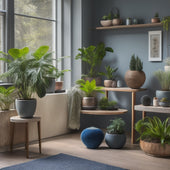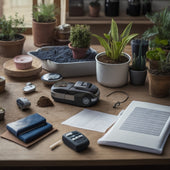
Why Aeroponic Systems Thrive in Rooftop Garden Designs
Share
By incorporating aeroponic systems into rooftop garden designs, you can harness the power of precise nutrient delivery and watering schedules to boost crop yields by up to 30% while using a staggering 90% less water than traditional soil-based methods. This leads to improved plant growth, higher yields, and reduced crop failure, all while alleviating stress on rooftop structures. As you explore the intricacies of aeroponic systems, you'll discover how to maximize space, optimize nutrient delivery, and fine-tune climate control, ultimately revealing the full potential of your rooftop garden - and that's just the beginning of what's possible.
Key Takeaways
• Aeroponic systems thrive in rooftop gardens due to their ability to conserve water, reducing weight stress on the rooftop structure.
• Precise control over nutrient delivery and watering schedules enhances plant growth rates, leading to higher yields and reduced crop failure.
• Vertical growing modules and wall-mounted planters maximize space, increasing yield per square foot in limited rooftop areas.
• Climate control and monitoring systems ensure optimal growing conditions, allowing for data-driven decisions to address climate-related issues promptly.
• Aeroponic systems can be designed for easy maintenance access, making it simpler to care for plants and ensure ongoing efficiency.
Aeroponic System Design Benefits
By incorporating aeroponic systems into rooftop gardens, you can capitalize on several design benefits that enhance overall efficiency and productivity.
One significant advantage is improved plant growth, which is facilitated by the precise control over nutrient delivery and watering schedules. This results in faster growth rates, higher yields, and reduced crop failure.
Additionally, aeroponic systems promote water efficiency, using up to 90% less water than traditional soil-based methods. This not only conserves this valuable resource but also reduces the weight and stress on the rooftop structure, ensuring a safer and more sustainable growing environment.
Moreover, the closed-loop system minimizes water waste and prevents runoff, reducing the risk of waterborne diseases and pests.
Key Components for Rooftop Success
To achieve rooftop success, you'll need to integrate several vital components into your aeroponic system, each playing an essential role in creating a thriving and sustainable growing environment. These components work together to guarantee a safe and efficient growing space, allowing you to reap the benefits of aeroponic gardening.
Here are three key components to focus on:
-
Plant selection: Choosing the right plants for your rooftop aeroponic system is vital. Select plants that are well-suited for aeroponic growing, such as leafy greens, herbs, and microgreens. Consider factors like climate, sunlight, and wind resistance when making your selection.
-
Water conservation: Aeroponic systems are known for their water efficiency, but it's still important to implement water-saving measures. Use a closed-loop system to recirculate water, and consider implementing rainwater harvesting or greywater reuse.
-
Structural support: Your rooftop aeroponic system needs a sturdy structure to support the weight of the plants, growing medium, and water. Confirm your system is designed and installed by a professional to prevent collapse or damage.
Maximizing Space With Verticals
As you design your rooftop aeroponic system, incorporating vertical growing modules can greatly increase your yield per square foot, allowing you to cultivate more plants in a smaller footprint. This is especially essential in rooftop gardens where space is often limited.
By employing vertical gardening techniques, you can optimize your space and make the most of your rooftop's dimensions. One effective way to do this is by using trellises or towers that allow plants to grow upwards, rather than outwards. This not only increases your yield but also creates a visually appealing display.
Additionally, you can utilize wall-mounted planters or living walls to further maximize your space. These space optimization strategies can be particularly useful in rooftop gardens with irregular shapes or narrow walkways.
When designing your vertical growing modules, be sure to take into account factors such as weight distribution, wind resistance, and accessibility for maintenance. By doing so, you can guarantee a safe and efficient aeroponic system that thrives in your rooftop garden.
Nutrient Delivery System Efficiency
Enhancing your aeroponic system's nutrient delivery relies on strategically placing pumps, tubes, and emitters to guarantee each plant receives the precise amount of nutrients, oxygen, and water necessary for ideal growth.
This precision is essential for peak nutrient absorption, which in turn boosts plant health and productivity.
To achieve maximum efficiency, consider the following key factors:
-
Emitter spacing: Verify emitters are spaced correctly to prevent overlapping or under-delivery of nutrients.
-
Pump pressure: Adjust pump pressure to accommodate the system's specific needs, avoiding over- or under-pressurization.
-
Tube diameter: Select the best tube diameter to minimize water flow resistance and prevent clogging.
Climate Control and Monitoring
Controlling the climate in your rooftop aeroponic garden is vital, since even slight temperature and humidity fluctuations can greatly impact plant growth and productivity.
You'll want to invest in a reliable temperature regulation system that can maintain ideal temperatures between 65°F to 75°F (18°C to 24°C) for most crops. This guarantees healthy root development and prevents stress on your plants.
Humidity management is equally important, as it directly affects transpiration rates and nutrient uptake. Aim to maintain a relative humidity of 40% to 60% to prevent moisture-related issues. You can achieve this by installing a dehumidification system or using passive ventilation techniques.
Additionally, consider implementing a climate monitoring system that tracks temperature, humidity, and light levels in real-time. This enables you to make data-driven decisions and respond promptly to any climate-related issues.
Frequently Asked Questions
How Often Should I Clean the Aeroponic System to Prevent Clogging?
You should clean your aeroponic system every 1-2 weeks to prevent clogging, focusing on high-risk areas like pumps and valves, and prioritize daily system maintenance checks to guarantee peak performance and safety.
Are Aeroponic Systems Suitable for Growing Root Vegetables Like Carrots?
You can successfully grow root vegetable varieties like carrots in aeroponic systems, as long as you provide adequate aeroponic root depth, typically 6-8 inches, to accommodate their growth, ensuring a safe and healthy harvest.
Can I Use Aeroponic Systems to Grow Plants in a Shaded Rooftop Area?
You think shaded rooftops are a lost cause, but surprise - they're a hidden gem! You can totally use aeroponic systems there, as long as you choose plants with low light requirements, ensuring ideal shaded growth.
How Do I Handle Power Outages and System Failures in an Aeroponic Setup?
When designing your aeroponic setup, you'll want to prioritize emergency preparedness by installing backup systems, such as battery-powered pumps and generators, to guarantee continuous operation during power outages and system failures.
Are Aeroponic Systems More Prone to Pests and Diseases Than Traditional Gardens?
You'll find that aeroponic systems aren't inherently more prone to pests and diseases, but rather, they require targeted pest management and disease prevention strategies, like sanitized equipment and controlled environments, to guarantee a safe and healthy harvest.
Related Posts
-

3 Best Tool Essentials for Creative Concrete Planters
To create visually stunning and durable concrete planters, you'll need three essential tool categories. First, you'll...
-

3 Best Tool Essentials for Creative Concrete Planters
To create visually stunning and durable concrete planters, you'll need three essential tool categories. First, you'll...
-

3 Best Tool Essentials for Creative Concrete Planters
To create visually stunning and durable concrete planters, you'll need three essential tool categories. First, you'll...
-

3 Best Tool Essentials for Creative Concrete Planters
To create visually stunning and durable concrete planters, you'll need three essential tool categories. First, you'll...
-

3 Best Tool Essentials for Creative Concrete Planters
To create visually stunning and durable concrete planters, you'll need three essential tool categories. First, you'll...
-

3 Best Tool Essentials for Creative Concrete Planters
To create visually stunning and durable concrete planters, you'll need three essential tool categories. First, you'll...
-

3 Best Tool Essentials for Creative Concrete Planters
To create visually stunning and durable concrete planters, you'll need three essential tool categories. First, you'll...
-

3 Best Tool Essentials for Creative Concrete Planters
To create visually stunning and durable concrete planters, you'll need three essential tool categories. First, you'll...
-

3 Best Tool Essentials for Creative Concrete Planters
To create visually stunning and durable concrete planters, you'll need three essential tool categories. First, you'll...
-

3 Best Tool Essentials for Creative Concrete Planters
To create visually stunning and durable concrete planters, you'll need three essential tool categories. First, you'll...
-

3 Best Tool Essentials for Creative Concrete Planters
To create visually stunning and durable concrete planters, you'll need three essential tool categories. First, you'll...
-

3 Best Tool Essentials for Creative Concrete Planters
To create visually stunning and durable concrete planters, you'll need three essential tool categories. First, you'll...
-

3 Best Tool Essentials for Creative Concrete Planters
To create visually stunning and durable concrete planters, you'll need three essential tool categories. First, you'll...
-

3 Best Tool Essentials for Creative Concrete Planters
To create visually stunning and durable concrete planters, you'll need three essential tool categories. First, you'll...
-

7 Best Concrete Planter Ideas for Indoor Gardens
You're looking for a stylish and low-maintenance way to bring some greenery into your home, and concrete planters off...
-

7 Best Concrete Planter Ideas for Indoor Gardens
You're looking for a stylish and low-maintenance way to bring some greenery into your home, and concrete planters off...
-

7 Best Concrete Planter Ideas for Indoor Gardens
You're looking for a stylish and low-maintenance way to bring some greenery into your home, and concrete planters off...
-

7 Best Concrete Planter Ideas for Indoor Gardens
You're looking for a stylish and low-maintenance way to bring some greenery into your home, and concrete planters off...
-

7 Best Concrete Planter Ideas for Indoor Gardens
You're looking for a stylish and low-maintenance way to bring some greenery into your home, and concrete planters off...
-

7 Best Concrete Planter Ideas for Indoor Gardens
You're looking for a stylish and low-maintenance way to bring some greenery into your home, and concrete planters off...
-

7 Best Concrete Planter Ideas for Indoor Gardens
You're looking for a stylish and low-maintenance way to bring some greenery into your home, and concrete planters off...
-

7 Best Concrete Planter Ideas for Indoor Gardens
You're looking for a stylish and low-maintenance way to bring some greenery into your home, and concrete planters off...
-

7 Best Concrete Planter Ideas for Indoor Gardens
You're looking for a stylish and low-maintenance way to bring some greenery into your home, and concrete planters off...
-

7 Best Concrete Planter Ideas for Indoor Gardens
You're looking for a stylish and low-maintenance way to bring some greenery into your home, and concrete planters off...
-

7 Best Concrete Planter Ideas for Indoor Gardens
You're looking for a stylish and low-maintenance way to bring some greenery into your home, and concrete planters off...
-

7 Best Concrete Planter Ideas for Indoor Gardens
You're looking for a stylish and low-maintenance way to bring some greenery into your home, and concrete planters off...
-

7 Best Concrete Planter Ideas for Indoor Gardens
You're looking for a stylish and low-maintenance way to bring some greenery into your home, and concrete planters off...
-

7 Best Concrete Planter Ideas for Indoor Gardens
You're looking for a stylish and low-maintenance way to bring some greenery into your home, and concrete planters off...
-

7 Best Concrete Planter Ideas for Indoor Gardens
You're looking for a stylish and low-maintenance way to bring some greenery into your home, and concrete planters off...
-

7 Best Concrete Planter Ideas for Indoor Gardens
You're looking for a stylish and low-maintenance way to bring some greenery into your home, and concrete planters off...
-

7 Best Concrete Planter Ideas for Indoor Gardens
You're looking for a stylish and low-maintenance way to bring some greenery into your home, and concrete planters off...
-

7 Best Concrete Planter Ideas for Indoor Gardens
You're looking for a stylish and low-maintenance way to bring some greenery into your home, and concrete planters off...
-

7 Best Concrete Planter Ideas for Indoor Gardens
You're looking for a stylish and low-maintenance way to bring some greenery into your home, and concrete planters off...
-

7 Best Concrete Planter Ideas for Indoor Gardens
You're looking for a stylish and low-maintenance way to bring some greenery into your home, and concrete planters off...
-

7 Best Concrete Planter Ideas for Indoor Gardens
You're looking for a stylish and low-maintenance way to bring some greenery into your home, and concrete planters off...
-

7 Best Concrete Planter Ideas for Indoor Gardens
You're looking for a stylish and low-maintenance way to bring some greenery into your home, and concrete planters off...
-

7 Best Concrete Planter Ideas for Indoor Gardens
You're looking for a stylish and low-maintenance way to bring some greenery into your home, and concrete planters off...
-

Accurate Measuring for DIY Block Planters Made Easy
As you begin building a DIY block planter, precise measurement is essential for a sturdy structure that can support s...
-

Accurate Measuring for DIY Block Planters Made Easy
As you begin building a DIY block planter, precise measurement is essential for a sturdy structure that can support s...
-

Accurate Measuring for DIY Block Planters Made Easy
As you begin building a DIY block planter, precise measurement is essential for a sturdy structure that can support s...
-

Accurate Measuring for DIY Block Planters Made Easy
As you begin building a DIY block planter, precise measurement is essential for a sturdy structure that can support s...
-

Accurate Measuring for DIY Block Planters Made Easy
As you begin building a DIY block planter, precise measurement is essential for a sturdy structure that can support s...
-

Accurate Measuring for DIY Block Planters Made Easy
As you begin building a DIY block planter, precise measurement is essential for a sturdy structure that can support s...
-

Accurate Measuring for DIY Block Planters Made Easy
As you begin building a DIY block planter, precise measurement is essential for a sturdy structure that can support s...
-

Accurate Measuring for DIY Block Planters Made Easy
As you begin building a DIY block planter, precise measurement is essential for a sturdy structure that can support s...
-

Accurate Measuring for DIY Block Planters Made Easy
As you begin building a DIY block planter, precise measurement is essential for a sturdy structure that can support s...
-

Accurate Measuring for DIY Block Planters Made Easy
As you begin building a DIY block planter, precise measurement is essential for a sturdy structure that can support s...
-

Accurate Measuring for DIY Block Planters Made Easy
As you begin building a DIY block planter, precise measurement is essential for a sturdy structure that can support s...
-

Accurate Measuring for DIY Block Planters Made Easy
As you begin building a DIY block planter, precise measurement is essential for a sturdy structure that can support s...
-

Accurate Measuring for DIY Block Planters Made Easy
As you begin building a DIY block planter, precise measurement is essential for a sturdy structure that can support s...
-

Accurate Measuring for DIY Block Planters Made Easy
As you begin building a DIY block planter, precise measurement is essential for a sturdy structure that can support s...
-

Accurate Measuring for DIY Block Planters Made Easy
As you begin building a DIY block planter, precise measurement is essential for a sturdy structure that can support s...
-

Accurate Measuring for DIY Block Planters Made Easy
As you begin building a DIY block planter, precise measurement is essential for a sturdy structure that can support s...
-

Accurate Measuring for DIY Block Planters Made Easy
As you begin building a DIY block planter, precise measurement is essential for a sturdy structure that can support s...
-

Accurate Measuring for DIY Block Planters Made Easy
As you begin building a DIY block planter, precise measurement is essential for a sturdy structure that can support s...
-

Accurate Measuring for DIY Block Planters Made Easy
As you begin building a DIY block planter, precise measurement is essential for a sturdy structure that can support s...
-

Accurate Measuring for DIY Block Planters Made Easy
As you begin building a DIY block planter, precise measurement is essential for a sturdy structure that can support s...
-

Accurate Measuring for DIY Block Planters Made Easy
As you begin building a DIY block planter, precise measurement is essential for a sturdy structure that can support s...
-

Accurate Measuring for DIY Block Planters Made Easy
As you begin building a DIY block planter, precise measurement is essential for a sturdy structure that can support s...
-

Accurate Measuring for DIY Block Planters Made Easy
As you begin building a DIY block planter, precise measurement is essential for a sturdy structure that can support s...
-

Accurate Measuring for DIY Block Planters Made Easy
As you begin building a DIY block planter, precise measurement is essential for a sturdy structure that can support s...
-

Accurate Measuring for DIY Block Planters Made Easy
As you begin building a DIY block planter, precise measurement is essential for a sturdy structure that can support s...
-

Accurate Measuring for DIY Block Planters Made Easy
As you begin building a DIY block planter, precise measurement is essential for a sturdy structure that can support s...
-

Accurate Measuring for DIY Block Planters Made Easy
As you begin building a DIY block planter, precise measurement is essential for a sturdy structure that can support s...


